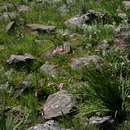ar
الأسماء في صفحات التنقل


Dierama is a genus of flowering plants in the family Iridaceae. Common names include hairbells, angel's fishing rod, fairybells, and wandflowers in English and grasklokkies (= grass-bells) in Afrikaans.[1] They are native to Africa, with most occurring in the southern regions of the continent.[2] The center of diversity is the province of KwaZulu-Natal in eastern South Africa.[1]
Plants of this genus are evergreen perennial herbs growing from large corms with fibrous tunics. The lowest two or three leaves are cataphylls that sheath the lower stem and become dry. The thin, wiry, branching stem may bend and droop when in flower. It is lined with leaves that have linear blades with thick longitudinal veins and often no midrib. The inflorescence is a panicle of several spikes of flowers. The spikes may hang like bells or grow erect. The bracts around the flowers are usually dry, thin, membranous, translucent, and streaked or veined with brown. The bell-shaped flowers of most wild species are pink; red, purple, yellow, and white taxa also exist.[2] There are many cultivars in a range of colors, sometimes with spots of yellow or blue.[3] The fruit is a spherical capsule.[2]
The genus name is derived from the Greek word dierama, meaning "funnel," and alludes to the flower shape.[4]
There are about 44 species.[2]
Some species of dierama are cultivated as ornamental plants, such as the purple-pink-flowered D. pendulum.[12] The South African endemic D. erectum is grown for the large, pink flowers it bears on tall, erect stems. It is prone to attack by the bean weevil Urodon lilii.[14]
Certain species have been used in traditional African medicine and spiritual practices. D. erectum is used as an enema by the Sotho people and as a treatment for stomach problems. The corm of the plant is a fertility charm for bringing a good harvest.[14]
Some species, especially the narrow endemics, are decreasing in abundance due to loss of habitat. The South African natives D. ambiguum, D. erectum, and D. nixonianum are considered endangered species.[6]
Dierama is a genus of flowering plants in the family Iridaceae. Common names include hairbells, angel's fishing rod, fairybells, and wandflowers in English and grasklokkies (= grass-bells) in Afrikaans. They are native to Africa, with most occurring in the southern regions of the continent. The center of diversity is the province of KwaZulu-Natal in eastern South Africa.
 Dierama dracomontanum
Dierama dracomontanum
Dierama es un género de plantas, herbáceas, perennes y bulbosas perteneciente a la familia de las iridáceas. Comprende 57 especies descritas y de estas, solo 44 aceptadas.[1] Es originario de Etiopía hasta el sur de África.
Sus cultivares producen flores de una gama de colores desde el blanco hasta el rojo oscuro. Conserva algo de follaje durante casi todo el invierno en las zonas templadas, pero su principal estado durante la etapa de invernada es un cormo o más bien de una cadena de bulbos similares a los de las especies de Crocosmia.
El género fue descrito por K.Koch y publicado en Index Sem. Horto Bot. Berol.[2]
Dierama nombre genérico que deriva del griego: dierama, que significa "embudo", y alude a la forma de la flor.[3]
Dierama es un género de plantas, herbáceas, perennes y bulbosas perteneciente a la familia de las iridáceas. Comprende 57 especies descritas y de estas, solo 44 aceptadas. Es originario de Etiopía hasta el sur de África.
Dierama est un genre de plantes de la famille des Iridaceae.
Ce sont des plantes herbacées, vivaces et bulbeuses originaires d'Afrique depuis l'Éthiopie jusqu'à l'Afrique du Sud.
Selon World Checklist of Selected Plant Families (WCSP) (30 janv. 2011)[1] :
Dierama est un genre de plantes de la famille des Iridaceae.
Ce sont des plantes herbacées, vivaces et bulbeuses originaires d'Afrique depuis l'Éthiopie jusqu'à l'Afrique du Sud.
Dierama – rodzaj roślin należący do rodziny kosaćcowatych (Iridaceae). Obejmuje 44 gatunki[3][4][3]. Rośliny te występują w naturze głównie w Afryce Południowej, między Półwyspem Przylądkowym a KwaZulu-Natal[3], nieliczne sięgają dalej na północ rosnąc w górach wschodniej Afryki po Etiopię[5][3]. Rosną w różnych siedliskach – od pęknięć w skałach, poprzez formacje trawiaste, wrzosowiskowe i zaroślowe po górskie mokradła[3]. Niektóre gatunki uprawiane są w klimacie ciepłym jako rośliny ozdobne. Są trwałe i niewymagające o ile rosną w miejscach słonecznych[3].
Rodzaj z plemienia Croceae, z podrodziny Crocoideae z rodziny kosaćcowatych (Iridaceae)[7].
Dierama – rodzaj roślin należący do rodziny kosaćcowatych (Iridaceae). Obejmuje 44 gatunki. Rośliny te występują w naturze głównie w Afryce Południowej, między Półwyspem Przylądkowym a KwaZulu-Natal, nieliczne sięgają dalej na północ rosnąc w górach wschodniej Afryki po Etiopię. Rosną w różnych siedliskach – od pęknięć w skałach, poprzez formacje trawiaste, wrzosowiskowe i zaroślowe po górskie mokradła. Niektóre gatunki uprawiane są w klimacie ciepłym jako rośliny ozdobne. Są trwałe i niewymagające o ile rosną w miejscach słonecznych.
Dierama é um género botânico pertencente à família Iridaceae.[1]
Änglametspösläktet (Dierama) är ett släkte i familjen irisväxter med cirka 43 arter från södra Afrika.
Änglametspösläktet (Dierama) är ett släkte i familjen irisväxter med cirka 43 arter från södra Afrika.